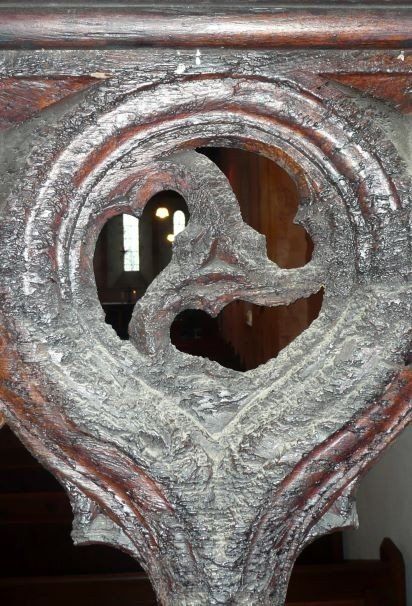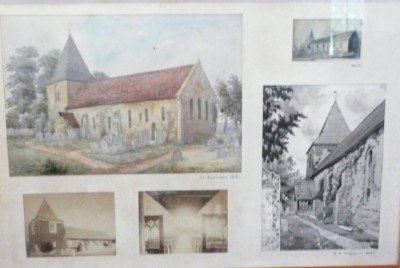St Nicholas Tour
Welcome to our tour, where we show you round St Nicholas
The building we know as St Nicholas dates from 1178, so has seen a lot of changes. The building reflects this in the marks and features of the stonework, screens and furniture. Our tour leaflet takes you round St Nicholas and these pages add a little more to your tour.

St Nicholas lies on the east side of Thorney Island. Public access is down the coast path from Prinsted. You will be walking into the lonelier part of the harbour, along sea walls built in the 1880's to link the Island to the mainland.

Thorney Island appears in the 1086 Doomsday book in the care of a monk, which suggests that there was a church or monastic building at that time. St Nicholas' Chancel & Choir date from the 12th century, while the Nave is of later construction and now narrower than the earlier building.
There is mention of a roadway to the east of the church, though this may have been lost to coast erosion or be an old gravel hard down to the channel?

Looking across Thorney Channel into the Harbour, there are clear views across to the Cathedral and the churches of Bosham and Chidham from the war graves cemetery. This means that St Nicholas get a good dose of weather when the wind is in the east.
The churchyard is a pleasant place to while away an afternoon, to watch the tide flow and ponder the great and the insignificant.

The Font is where most people begin their Christian journey, a place where we splash the baby's head to mark its start along the journey. Our font is probably a large block of Caen stone, being of a Norman chevron design, with 12 rounded arches - the same round arches are on the Bayeux Tapestry.
The font is sized to allow full immersion of an infant, a common practice in the 12th Century. These days we use the sailing club slipway for full immersion.
West Wittering church has a similar shaped font, perhaps they arrived on the same boat from Normandy.

We don't know where this icon comes from that shows St Nicholas baptising three boys in a barrel. They look non-plussed about it.
St Nicholas is a saint originating in southern Turkey and is credited with the giving of gifts incognito. Patron saint of sailors and fishermen, Thorney Island is the right place for him. Known by many names in many traditions, the idea of giving without seeking reward, merit or repayment lies at the heart of the Christian tradition.

Our weather vane is our beacon of faith in the harbour. In times past, it acted as the weather forecast to show the wind that would bring tomorrow's weather.
Re-gilded in 2009, you may be able to see the bullet hole in it. Some say the Luftwaffe did this when the airfield was attacked in the 1940s, but others suggest a bored sentry may have livened his time with a bit of target practice. What do you think?

The Nave screen is a combination of 14th Century oak carvings with more modern spindles and frame. The carving is a three legged motif that signifies the Trinity - a complex theological concept for the visualisation of God as Father, Son and Holy Spirit. The low literacy of the 14th Century mind was offered a simple motif to remember the three ways God is encountered in the Bible. Our 21st Cent Vestry cupboards repeat this motif.
The screen was probably placed much further forward in previous times to separate the Sanctuary (where priests and lords sat) from the Nave (where the the serfs stood). Its new position shows how social equality has evolved in England.

The Novgorod Icon is a representation of St Nicholas from the Orthodox tradition. Being from southern Turkey, St Nicholas was first recognised in Constantinople, now Istanbul. He was probably encountered by many Western Christians during the Crusades (from 1095 to 1291) who would have passed through Constantinople on their way eastwards. Many of the richer ones may have survived sea journeys from Italy and were rightly thankful.
We have placed this icon next to the votive where candles can be lit to remember those dear or to accompany your prayers.

The flags remember the military units serving from the Island. The RAF flag flew on the station until 1976 and is much patched. The Royal Artillery flag flew in Germany with 12th Regiment RA until recalled home to Thorney Island as the British Army of the Rhine (BAOR) returned home in 2012, having secured the peace in Western Europe for 65 years.
The flags over the Vestry screen are identifiers for artillery batteries, often camouflaged within the landscape, so essential for their logistical support.
The battery insignia on the flags and the 47 RA lectern recall famous engagements that have punctuated a British history that spans the world. The cap badge of the Royal Artillery sum this up in one word: 'Ubique' - Everywhere.

The renovation in the 1880's are believed to have exposed the columns and arches that were hidden in the walls by the 1660s renovation. This suggests that St Nicholas was a 3 aisle building, so much wider than we see today. Surveys in the churchyard have failed to find any foundations to what would have been outer walls, which may account for why the aisles did not survive. The buttress beside the porch is believed to be part of an old gable.
For a small island to have a 3-aisle church suggests that a large community, could be accommodated. Perhaps the religious community based here at the time of the Doomsday book continued through to Henry VIII's dissolution of the monastic houses? If so, faith was a large part of the Island life.

The commemorative window records the time of the Royal Air Force on Thorney Island. Starting as a Coastal Command base, through the 1940's air war to a transport and support role into the 1970's. The bird is a Lapwing on a nest of thorns. Rarer now, the Lapwing is also the motif on the sailing club flag. Many RAF veterans recall their time on Thorney Island with much affection.

Our memorials record the the units that have served on and from Thorney Island. The squadron boards record the aircraft flown from the Island and chart the evolution of the air station's role. The tide of the 1940's air war, turning from defense of our sea-lanes to the liberation of Europe, is recorded in the planes that flew from here. So too is the evolution to a transport role to support a receding Empire and then local air-sea rescue and training roles.
The Royal Artillery Regiments that were stationed on the Island are also remembered here. Regiments that returned from Germany are now serving in Estonia as the geo-politic shifts.

The Nave has a Victorian tiled aisle and an oak herringbone floor under the yew pews. Beyond is the Choir, being the older part of the building. The Chancel has larger plain windows, the dawn sun streams through to create a bright space.

The pulpit is in slate on an oak frame and dates from the RAF days. The motif is 2 Squadron Air Navigation School which was based here from the 1960's. The emblem is a pierced flaming torch, but is known as the flaming parsnip.

These small windows in the Choir are original to the 12th Century building and show a typical Norman style. The width of the walls are clearly seen here and show the reason St Nicholas has withstood the weather. The early churches must have been dark and mysterious spaces, screened by a rood and the place to meet with God.

The three panels in the Choir contain old images of St Nicholas that were found in the Rectory when it closed in 1976. This one has a drawing of the building in the 1790's and later photos. A piece form the Diocesan gazette describes Thorney Island as a rural idyll.

This next panel has similar images of St Nicholas in the past. The internal photos show the 14th century screen in its present position so must date after the 1880's. The layout of the paths was much different.

This last panel shows St Nicholas from the North, before the large yews had established. That North door has since been replaced by the RAF Window. In time we hope to place these images in their own pages on the website.

George I's royal coat of arms is called a hatchment and dates from the 1714 when the Hanovarian line was invited to become kings of England. The religious tussle between the catholic Jacobites, supported by France and this protestant accession would see invasions of England from Scotland in 1715 and 1745.
This hatchment was the way George stamped his authority throughout the land, directing it to be displayed in all churches. The motto 'God is my Right' sums this up, tho' I think the lion looks rather unsure.

The kneelers at the altar rail recall the RAF at Thorney Island, in embroidery. RAF wives created a record of the squadrons and aircraft serving in the 1960's in a very practical and functional way. A framed dedication of these can be found on the wall of the Chancel.
Look through them to see the range of aircraft flying then.

The altar is the table on which the Last Supper is commemorated during the Holy Communion service. The sharing of Jesus' last meal of bread and wine today links us back through time to all who have practiced this deeply symbolic ritual.
The altar is an RAF folding design for transport on aircraft, so the Chancel can be used creatively at other times.
The liturgical colours are changed through the church year, the red being used for Remembrance Sunday. White signals festivals like Christmas, Easter and thro' Pentecost to Ascension; purple for seasons of Epiphany and Lent. Green takes through the summer months of Trinity, which is why green is our most faded of the altar frontals.
We try to keep the squirrels out of the church as they want to nibble the fringes.
Bear with us while we continue building
Where to find us:
Church Road, Thorney Island,
Emsworth, PO10 8DS, Great Britain
curator@stnicholastimeline.org.uk
Copyright © All Rights Reserved.
